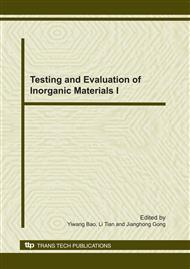p.657
p.660
p.665
p.669
p.673
p.677
p.682
p.686
p.690
Preparation and Magnetic Properties of Carbon Encapsulated Fe-Cu Alloy Nanoparticles
Abstract:
Carbon encapsulated Fe-Cu alloys nanoparticles were synthesized by using ferric nitrate, copper nitrate as metal sources and using sucrose as carbon source. The synthesis process involved a step of hydrazine hydrate reduction in alcohol solution and a step of annealing carbonization. The as-prepared samples were characterized by X-ray diffraction technique, X-ray energy dispersion spectrograph, trans- mission electron microscopy and Raman spectroscopy. The results showed the sample was core / shell structure, the metalic core was crystalline FeCu4 alloy, the shell was amorphous carbon, and the average particle size was about 51nm. The magnetic measurement by using a vibrating sample magnetometer revealed that the sample has ultra-soft magnetic property with the saturation magnetization Ms of 13.01 emu/g, residual magnetization Mr of 0.37 emu/g and coercive forces Hc of 54.43 Oe at room temperature.
Info:
Periodical:
Pages:
673-676
Citation:
Online since:
December 2010
Authors:
Price:
Сopyright:
© 2011 Trans Tech Publications Ltd. All Rights Reserved
Share:
Citation:


